Digital Twins or Triplets
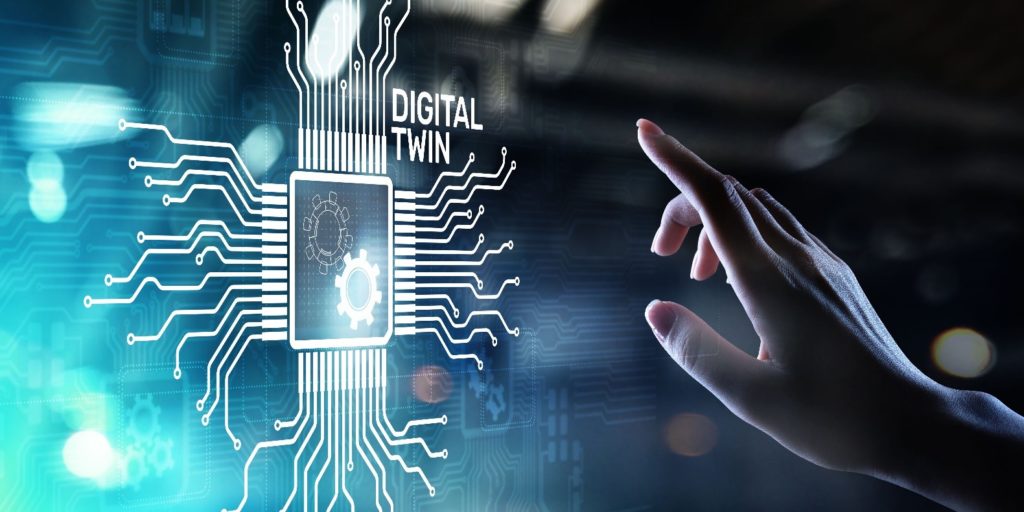
By SJ Global Academy
A “pretty large bang” was heard by the crew of Apollo 13 two days after their launch from the Kennedy Space Centre on 11th April 1970. This was followed by the immortal words “Okay, Houston, we’ve had a problem here”. The ignition and blast from an exposed wire inside an oxygen tank heralded a dramatic rescue by Mission Control in Houston 330,000 km away. The subsequent four-day odyssey home for the space shuttle was the quintessential “what can go wrong; will go wrong”. As has been said about that mission; “no one has been in this amount of trouble so far from home”.
There are many heroes in a rescue mission of this complexity. One of them is surely a “digital twin”. 15 simulators were connected to computers able to replicate the response to an immense number of technical permutations which would guide the craft home after circling the moon. The space shuttle and its crew landed safely in the Pacific Ocean on 17th April.
Today, a Google search for “digital twin” exceeds 300,000,000 results! Simply, it is the virtual representation (if you like, an avatar) of a physical system in real time. The idea is that the digital twin inhabits and exhibits the realities of a physical asset.
While technology progresses, its use is determined by cultures and people. In a fast paced, ever-changing digital era, not surprisingly for some, digital twins pervade many industries and aspects of private life today. Concepts in Industry 4.0 use digital twins in factory operations to monitor machine performance and spot problems. There are digital twins of hospitals, medical equipment and even human organs. Formula One racing is dominated by digital twins that predict problems, rectify difficulties and optimise the cars during an ultrahigh speed race. With over a hundred sensors in each car, billions of data (of tyre pressures, temperature, drag, acceleration, shifts in the locus of gravity, cockpit conditions) are transmitted via telemetry to remote command centres.
Neither is the built environment industry the last bastion to witness the influence of digital twins that will shape and transform its future. Digital twins will follow any industry impacted by big data. In fact, well before the built environment practice universally shifts from the classical use of two dimensional drawings and physical models to three dimensional, “living” models across the continuum of workflows, the profound value of the existence of information from these twins is already known.
In April 2019, the 12th century French Notre Dame Cathedral was ravaged by a devastating fire. The heroic work of a Vassar Professor, the late Andrew Tallon and his digital twin, restoring the Cathedral to its original design is now a realistic goal. Five years ago, in 2015, Professor Tallon used lasers to create point clouds of the Cathedral’s interior and exterior facades replete with gargoyles and spires. This is today the basis of the 3D digital rendering used in restoring this historical building.
Twins are Triplets in many ways. One of which is that their “DNA” depends on sophisticated software codes, data absorption abilities and pattern recognition (through machine learning or artificial intelligence). There are also commentators who describe twins as cyber, physical and social triplets because their properties manifest in all three realms. However it is viewed, what enables digital twins is the same technologies that propelled so many other revolutions: faster processing speeds, near unquenchable data ingestion capacities, cheap sensors’ ultra-integrated networks, communications rates and bandwidth, data storage, precocious analytical tools and new visualization techniques that allow the physical and digital worlds to meld and blend.
One way to think about the value of digital twins is its ability to participate in the entire built environment industry’s asset life cycle through concept, design, development, project management, construction and managed services. Take the example of the Virtual SingaporeTM platform. There has been much adulation in the media about Singapore’s vision to model and simulate the pulse of a vibrant city. The platform is surfeit with geospatial data about the city-state. It intends, when completed, to provide a digital space and experimental commons to make policy and design decisions, test hypotheses about urban systems and their interdependencies, model environmental impact on the landscape temporally and study community engagements in townships and its surroundings. It is an ambitious digital twin project made successful only by organisations and people able to harness its value.
With Surbana Jurong’s (SJ) domain expertise in the built environment, we have generated 3D models, large scale simulations and high dimensionality building information modelling (BIM) systems in a wide array of areas such as transport, flood control, engineering, masterplanning, design and asset management. And with our ability to incorporate data ingestion, digital twins have also been created. For instance, SJ’s VR City platform (see illustrations 1a, 1b & 1c) is a solution to test infrastructure and its design in response to connections and neighbouring dependencies. On it, changes can be made in a myriad of ways and candidate solutions derived through better information and consequently, preferred outcomes. The vision is to simulate a smart, conscious city that constantly monitors, among other factors, ambient conditions, traffic, accidents, emergencies, commuter and pedestrian patterns. Information is then channeled to an integrated operations centre and the appropriate responses transmitted to the relevant people or agencies.
Illustration 1 – SJ VR City can integrate a variety of data sources and is a convenient platform for urban planners to visualize and study the environment
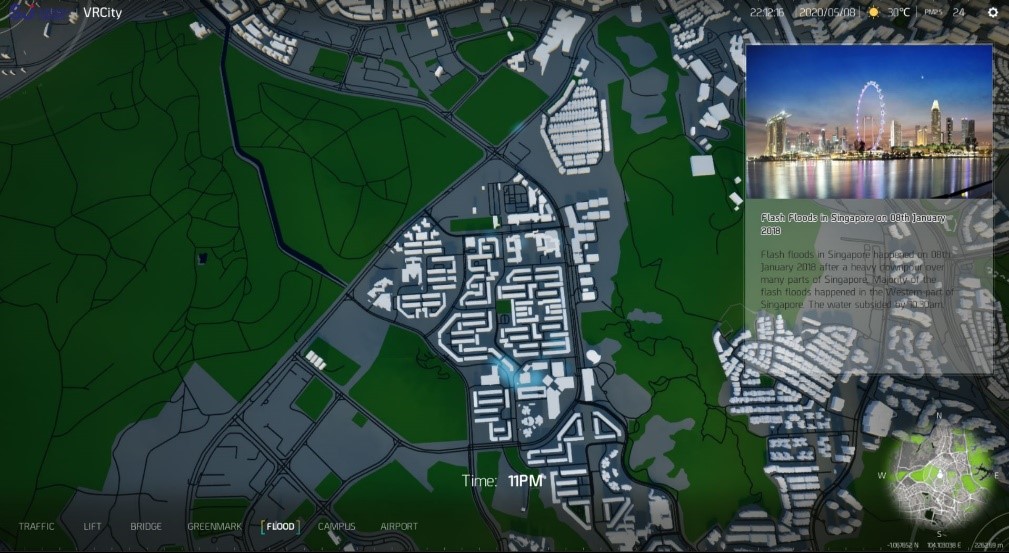
Illustration 1a – Flood simulation analysis – use of stormwater management model integrated into 3D model to identify vulnerable regions prone to flooding.
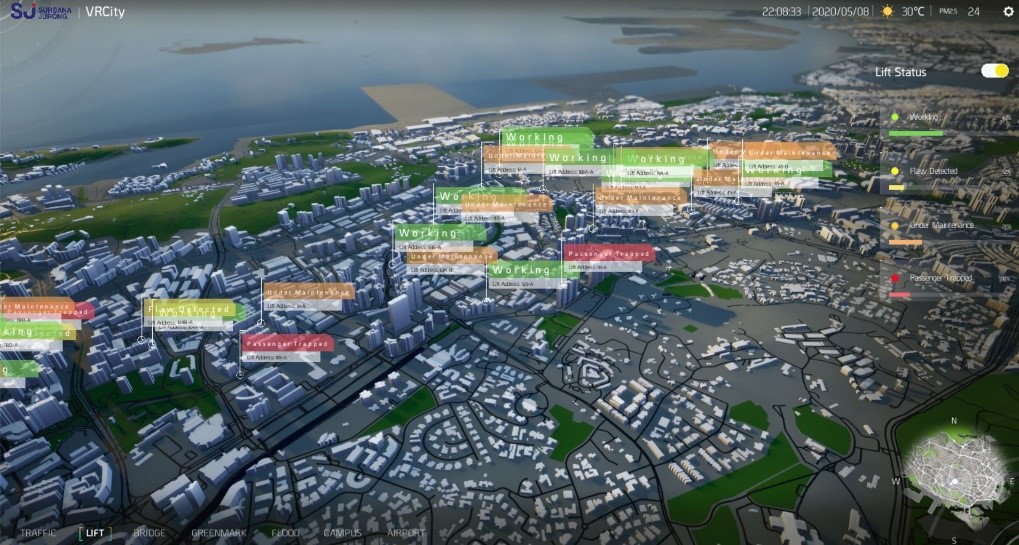 Illustration 1b – In city-wide lift or critical M&E asset monitoring, users will have a pictorial overview of asset status and condition and drill-in to the individual asset as necessary to query or activate a follow-up.
Illustration 1b – In city-wide lift or critical M&E asset monitoring, users will have a pictorial overview of asset status and condition and drill-in to the individual asset as necessary to query or activate a follow-up.
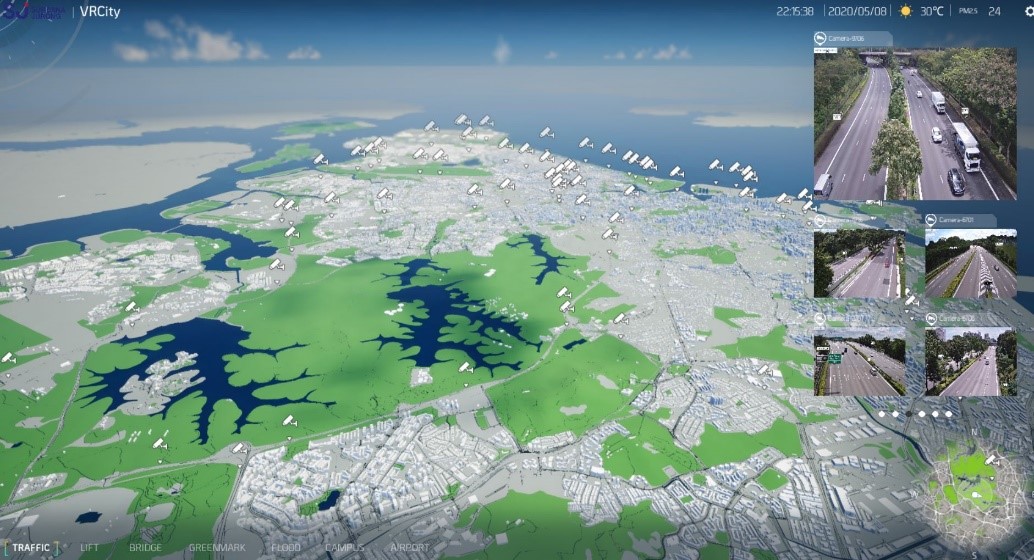 Illustration 1c – Traffic monitoring with associated video analytics allows users to zoom in to road conditions or troubled spots to advise on diversionary routes to ease congestion or assist police in tracking rouge vehicles.
Illustration 1c – Traffic monitoring with associated video analytics allows users to zoom in to road conditions or troubled spots to advise on diversionary routes to ease congestion or assist police in tracking rouge vehicles.
We are creating digital twins of our Moshe Safdie-designed SJ Campus harnessing the power of BIM, IoT, artificial intelligence, integrated digital delivery, sensor networks and new age visualisation tools (see illustrations 2a & 2b). To accomplish an equilibrium from many complex factors, the campus demonstrates the use of integrated twins from concept to construction, to long term maintenance. The aim is to create a balanced tropical ecology of light and shade, cooling and radiation deflection, and excellent air circulation and quality. The campus will become a living, pulsating laboratory responding to internal and external ambient factors and always sentient.
Illustrations 2a & 2b – Creating digital twins of Moshe Safdie-designed SJ Campus harnessing the power of BIM, IoT, artificial intelligence, integrated digital delivery, sensor networks and new age visualisation tools.
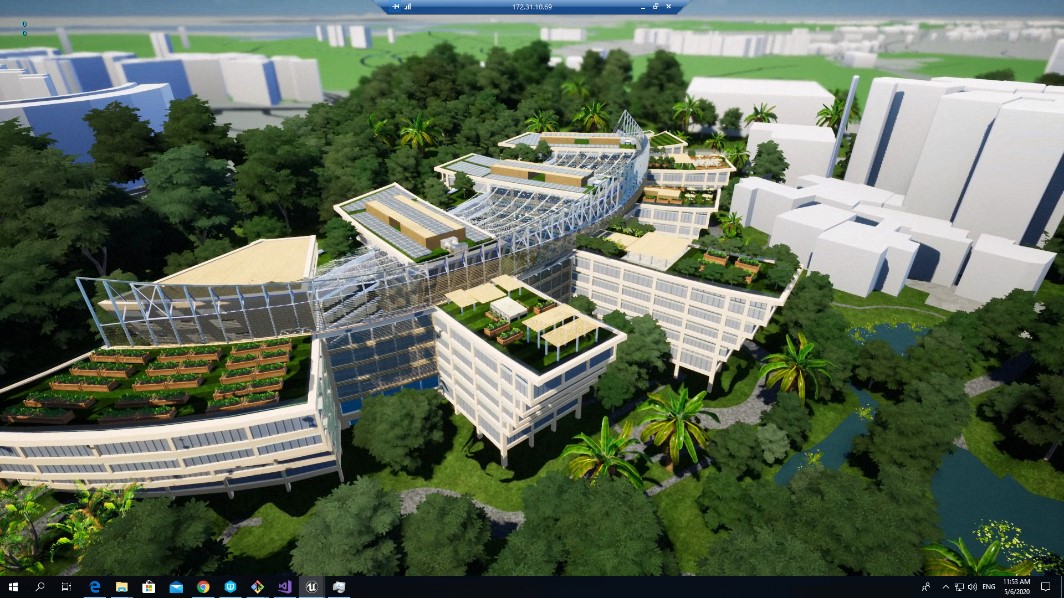
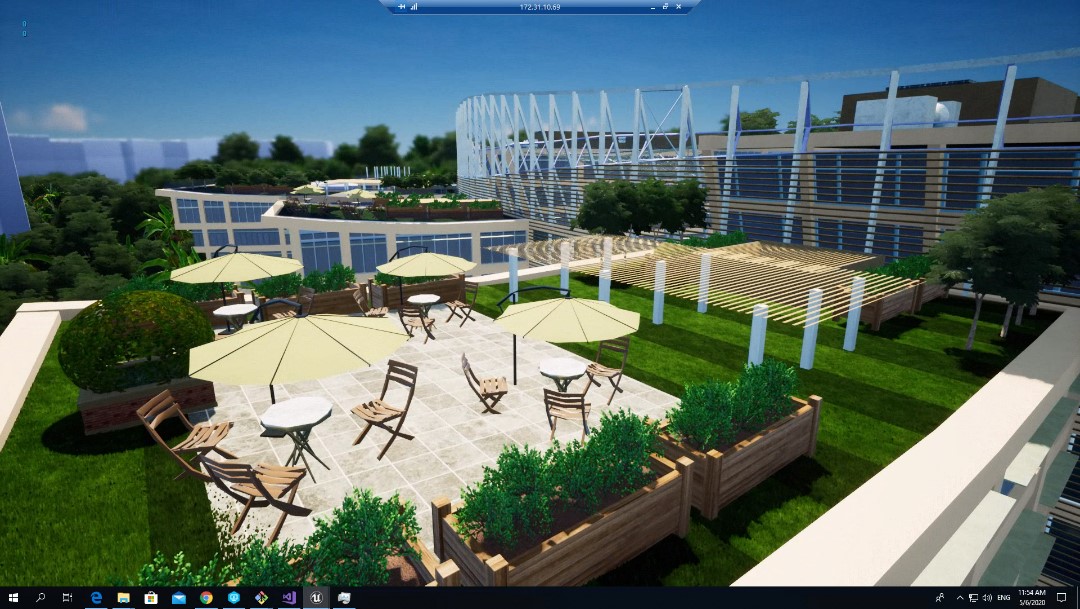
The constituents of cities and campuses are physical assets – some critical ones such as lifts, airports or hospitals – whose properties are embodied by their twins. If these constituents, each as digital twins, are connected, a digital thread is created. This gives us a glimpse of a future where the connected twins can collaborate with each other, share information and respond in ways that optimise the properties of the group or network. Therefore, in SJ, we embrace a multi-scale, multi-functionality, multidisciplinary strategy to our development of digital twins and its associated technologies. This way, our culture of ideas, creativity and collaboration is not limited by technologies or disciplinary specialisations.
The attractiveness of digital twins should not of course disguise difficulties. One inhibitor is the cost of creating and maintaining digital twin assets. This presents an opportunity for a business model innovation for consultants to become custodians and managers of digital assets for their clients. Providing services that governs and regularly improves data security, storage and integrity enhances model quality, refreshes technology and acts on other important factors of managing the twin. There is substantial evidence of an industry that has rapidly burgeoned in a short period offering digital twin development services. Another that offers twin and digital asset management and quality assurance services will surely emerge soon, perhaps akin to another data management and applications hosting industry known as cloud service providers.
Digital twins or triplets, quadruplets or siblings, virtual avatars have emerged from the realms of imagination to reality in businesses. Ultimately, as history has proven, companies that are adept at creating, using, innovating and improving through technologies like digital twins will have distinct and formidable advantages over those less able.



